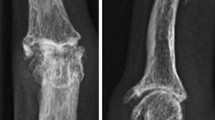Summary
At the departement for plastic and reconstructive surgery of the university of Vienna a modified coriumarthroplasty was used to treat deformities of the finger joints due to rheumatoid arthritis for several years. A follow-up of 32 MP arthroplasties and 1 PIP arthroplasty 3–5 years after the operation revealed an active motility of 28 MP joints of 45 degrees in the functionally important range. Only 4 MP joints had a motility of less than 30 degrees.
Since January 1969 silicon rubber implants of Swanson design were used in 31 MP and 11 PIP joints. The small number and the short follow up do not allow final conclusions to be drown but it was felt that a follow-up study should be undertaken to compare these two groups.
All 31 MP joints remained 1 to 2.5 years after operation free of pain. There was no tendency for ulnar deviation. The stability of the joints was excellent. There was free active motility:
more than 45° | 19 MP | 1 PIP joint |
30°–45° | 7 MP | 7 PIP joint |
less than 30 ° | 4 MP | 3 PIP joint |
a roentgen-cinematographic study of the cases after coriumarthroplasty demonstrated that the good motility of the joints was due to a slight palmar subluxation during flexion. This explains why the lateral stability could not be very good. It was improved by a modified technique (Kretschy, Millesi, Siegmund, 1966; Millesi, 1967) but was still not fully satisfactory. After silicon rubber implant the lateral stability was much better. Abduction and adduction was preserved. The range of flexion and extension was less in cases of silicon rubber implant but sufficient for good function.
Because of the good functional results and the simple technique the use of silicon rubber implants is recommended. If a very large range of motion of the MP-joints is desired, for instance in cases of stiff PIP joints there is still an indication for a coriumarthroplasty.
Zusammenfassung
2 Patientengruppen wurden miteinander verglichen. Die eine Gruppe bestand aus 32 Coriumarthroplastiken des Grundgelenkes und einer Coriumarthroplastik des proximalen Interphalangealgelenkes. Die zweite Gruppe umfaßt 31 Grundgelenke und 11 proximale Interphalangealgelenke, bei denen Swansonprothesen aus Silikongummi zur Wiederherstellung der Gelenksfunktion nach Gelenkszerstörung im Rahmen einer progressiven chronischen Polyarthritis verwendet wurden.
Nach Coriumarthroplastik wurde bei der Mehrzahl der Fälle ein größeres Bewegungsausmaß erzielt, die seitliche Stabilität ließ etwas zu wünschen übrig. Alle Fälle, bei denen eine Silikongummiprothese verwendet wurde, waren 1–2,5 Jahre nach der Operation schmerzfrei, es bestand keine Tendenz zur Entwicklung einer neuerlichen Ulnardeviation, die seitliche Stabilität war gut, die Beugung bzw. Streckung ausreichend. Die Verwendung der Swansonprothese kann daher, vor allem auch wegen der einfachen Technik, empfohlen werden. Bei Fällen, die ein besonders großes Bewegungsausmaß benötigen, wie z.B. bei steifen PIP-Gelenken, halten wir nach wie vor die Coriumarthroplastik für indiziert.
Similar content being viewed by others
Literatur
Flatt, A. E.: The prothetio replacement of rheumatoid finger joints. Rheumatism16, 90–97 (1960).
Fowler, S. B.: Arthroplasty of metacarpophalangeal joint in rheumatoid arthritis. J. Bone Jt Surg. A44, 1937 (1962).
Harrison, S. H.: Rheumatoid deformities of the proximal interphalangeal joints of the hand. Ann. rheum. Dis.28, Suppl. 5, 20–22 (1969).
Kretschy, A., Millesi, H., Siegmund, G.: Operative Korrektur der im Rahmen der chronischen Polyarthritis rheumatica auftretenden Handdeformationen. Klin. Med. (Wien) Heft 4,21, 166–175 (1966).
Marmor, L.: Hand surgery in rheumatoid arthritis. Arthr. and Rheum.5, 419–424 (1962).
Millesi, H.: Fingerverformungen nach Operationen wegen Polydaktylie. Klin. Med. (Wien)22, 266 (1967).
Millesi, H.: Spätergebnisse der Korium-Arthroplastik an den Fingergelenken. Handchirurgie 1., H. 4, 215–222 (1969).
Swanson, A. B.: A flexible implant for replacement of arthritic of destroyed joints in the hand. Surg. Clin. N. Amer.48, 1113 (1968).
Swanson, A. B.: Silicone rubber implants for replacement of arthritic of destroyed joints in the hand. Surg. Clin. N. Amer.48, 1113 (1968).
Vainio, K.: The role of surgery in the rehabilitation of rheumatoid arthritis patients. Proc. 4th European Rheumat. Cong. 223–230 (1959).
Author information
Authors and Affiliations
Rights and permissions
About this article
Cite this article
Millesi, H. Wiederherstellung der Fingergelenksfunktion durch Silikongummi-Interponate nach Swanson. Chir Plastica 1, 157–165 (1972). https://doi.org/10.1007/BF01799096
Received:
Issue Date:
DOI: https://doi.org/10.1007/BF01799096



